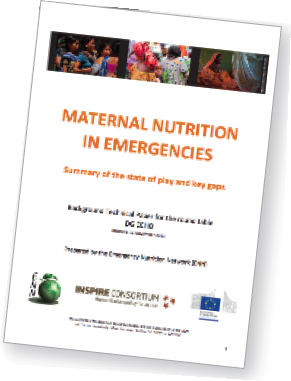Maternal nutrition in emergencies: Summary of the state of play and key gaps
 Tanya Khara and Emily Mates, ENN
Tanya Khara and Emily Mates, ENN
Available at www.ennonline.net
Current evidence underlines the importance of the nutritional status of women at the time of conception, during pregnancy and through lactation as a crucial factor in the survival, healthy growth and development of her children. Although it is the subject of less global attention, maternal nutrition is also crucial for women’s own ability to live a healthy life.
Concerned that there are a number of gaps at policy and practice levels and limited guidance is available to efficiently and effectively address the needs for maternal nutrition, the European Commission commissioned a review of the literature and existing guidance.
This review summarises the available literature relating to women’s vulnerabilities, the implications of these for women and their infants, current international guidance on maternal nutrition and what is currently being done in emergency programming. Key gaps are highlighted.
Current guidance on maternal malnutrition has been limited until recently, with the publication of the World Health Assembly of a 2012 WHO report ‘Nutrition of women during pregnancy’ and the publishing of the WHO 2013 Essential Nutrition Actions for improving maternal, newborn, infant and young child health and nutrition. The Scaling Up Nutrition (SUN) Framework includes a number of direct interventions for maternal nutrition, although the emergency context is not specifically addressed. The SPHERE project 2011 gives some guidance, however most are linked to infant feeding and the welfare of the child only.
The review pulls together available guidance on macronutrient supplementation, micronutrient supplementation, care and support, health related interventions, and nutrition sensitive interventions for improving maternal nutrition generally and in emergencies.
Key gaps identified include:
- Knowledge gaps in how to assess and analyse, who to target, and what is the most effective response
- What specific products to use for micronutrient supplementation and for supplementary feeding
- How to monitor effectiveness and evaluate impact of emergency programmes on pregnant and lactating women and their children.

